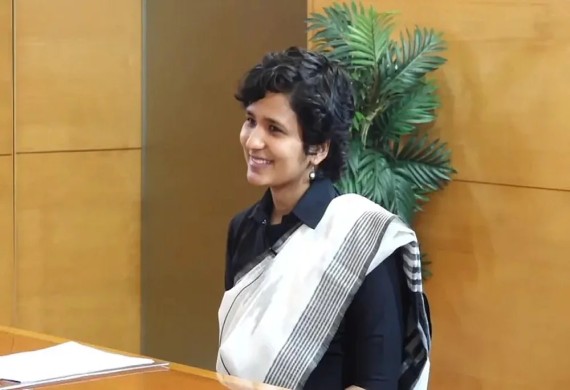
On The Civil Services Results for 2021, Women are at the Top
By: WE Staff | Thursday, 2 June 2022
Three women, Shruti Sharma, Ankita Agarwal, and Gamini Singla, took first, second, and third places, respectively, in the Union Public Service Commission's 2021 Civil Services examinations (UPSC). One of the most difficult exams to pass, the girls were able to finish first in their second attempts, and second in their third attempts in the case of the second-place finisher. All three women agreed that the road had been long, arduous, and difficult. There's a lot to celebrate — and ponder — with 10 of the top 25 rank-holders being women.
According to the Ministry of Education's latest All India Survey on Higher Education report for 2019-2020, the gross enrolment ratio in higher education for women is 27.3 percent, compared to 26.9 percent for men. Women made up only 26% of the 685 candidates recommended by the UPSC for appointment to the Indian Administrative Service (IAS), Indian Foreign Service (IFS), Indian Police Service (IPS), and Central Services, Group A and B.
This skewed statistic must change because public service provides a unique opportunity to effect social change, and women can be the driving force behind it, especially in a country where girls are frequently forced to drop out of school for a variety of reasons, including poverty, early marriage, and a lack of toilets.
Ms. Sharma is from Bijnor (Uttar Pradesh), Ms. Agarwal is from Kolkata, and Ms. Singla is from Sunam (Punjab), and their stories are all about perseverance and suffering. Women have battled hard to get this far in the IAS, and once inside the steel structure of the administrative setup, they may face a more difficult journey.
If three women are at the top today, they owe a debt of gratitude to trailblazers like Anna Rajam Malhotra (née George), the first woman to join the Indian Administrative Service in 1951, or C.B. Muthamma, the first woman to join the Indian Foreign Service in 1948, who fought a landmark case in the Supreme Court of India when she was passed over for a promotion to Ambassador, or even Anita Kaul, who worked tirelessly to champion the Right to Education Act.
A civil servant's early years are usually spent in rural or semi-urban India, giving her a unique perspective on issues such as women's health, literacy, economic independence, caste, and gender disparities, all of which require reform or policy intervention but are frequently overlooked due to a lack of knowledge. Education is the key to achieving this. In addition, if the civil service is to reflect all sectors of the population, half of whom are women, women's presence in the services must expand at all levels of the bureaucracy, beginning at the top.
Most Viewed
- 1 Women's Health Startup HerMD Closing Doors Amid Industry Challenges
- 2 5 Famous Women in Indian Armed Forces
- 3 Saudi Women No longer Require Male Permission for Clothing Choices, says Prince MbS
- 4 Kolkata Medtech Startup Innovodigm Raises Rs 5.5 Crore Seed Funding Led by IAN Group
- 5 Yamunanagar's Kashish Kalra Honoured after Securing 111th Rank in UPSC Civil Services Exam
- 6 Madurai Appoints Its First Woman Corporation Head
- 7 IAS Vijayalakshmi Bidari Appointed as the new Nagpur Divisional Commissioner
- 8 American Entrepreneur Lucy Guo Overtakes T Swift to become Youngest Female Billionaire
- 9 ICC Women's World Cup 2025 Trophy Showcased at Indore's Holkar Stadium
- 10 Aparna Saxena's Beauty Venture AntiNorm Launches in India
- 11 Vidya Nataraj Co-Founded BlueStone Jewellery & Lifestyle files IPO
- 12 5 Women Freedom Fighters of India
- 13 Dr. G Krishnapriya appointed as CEO for Trichy
- 14 M3M & Sirona Partner to Introduce Menstrual Hygiene Vending Machines in 15 Locations
- 15 Punjab Govt launches SHE Cohort 3.0 Supporting Tech-led Women Startups
- 16 Indian origin Lawyer, Sweena Pannu appointed as the US New Superior Court Judge
- 17 The Aurora Tech Award recognizes 4 Indian Women-led Startups
- 18 Kerala's Republic Day parade featured an all-female tableau
- 19 Manisha Kabbur Becomes Karnataka's First Woman International Karate Coach
- 20 Director K. S. Ravikumar's Daughter Maalica Ravikumar Launches Life Coaching Company 'Evergrowth Academy' for Women
- 21 Leezu's Raises Pre-Seed Funding to Accelerate Growth in Sexual Wellness Industry
- 22 Sattu: Super-easy summer drink for PCOS gut healing
- 23 Swathi Nelabhatla creates Sitha App, India's First Women-Exclusive Gig Platform
- 24 7 Timeless Female Kathak Dancers & their Iconic Legacies
- 25 Meet 7 Iconic Women Architects of Modern India & their Most Impactful Work
- 26 This Woman-led Insuretech Startup is Helping Bridge the Education Financing Gap in India
- 27 Women Leaders Share Lessons Learnt from India Women's WC Win
- 28 5 Enterprising Women Founders Powering Singapore's Tech & Innovation Landscape
- 29 4 Women. 4 Stories. One Vision for Smarter, Stronger Healthcare
- 30 Global Gender Gap Narrows to 68.8%, But Full Equality 123 Years Away: WEF Report 2025
- 31 Changemakers: 7 Women Entrepreneurs Taking the Make in India Movement Forward
- 32 Meet Lucy Guo, The Youngest Self-Made Female Billionaire Disrupting Tech
- 33 How Women are Driving India's Festive Online Shopping Surge






